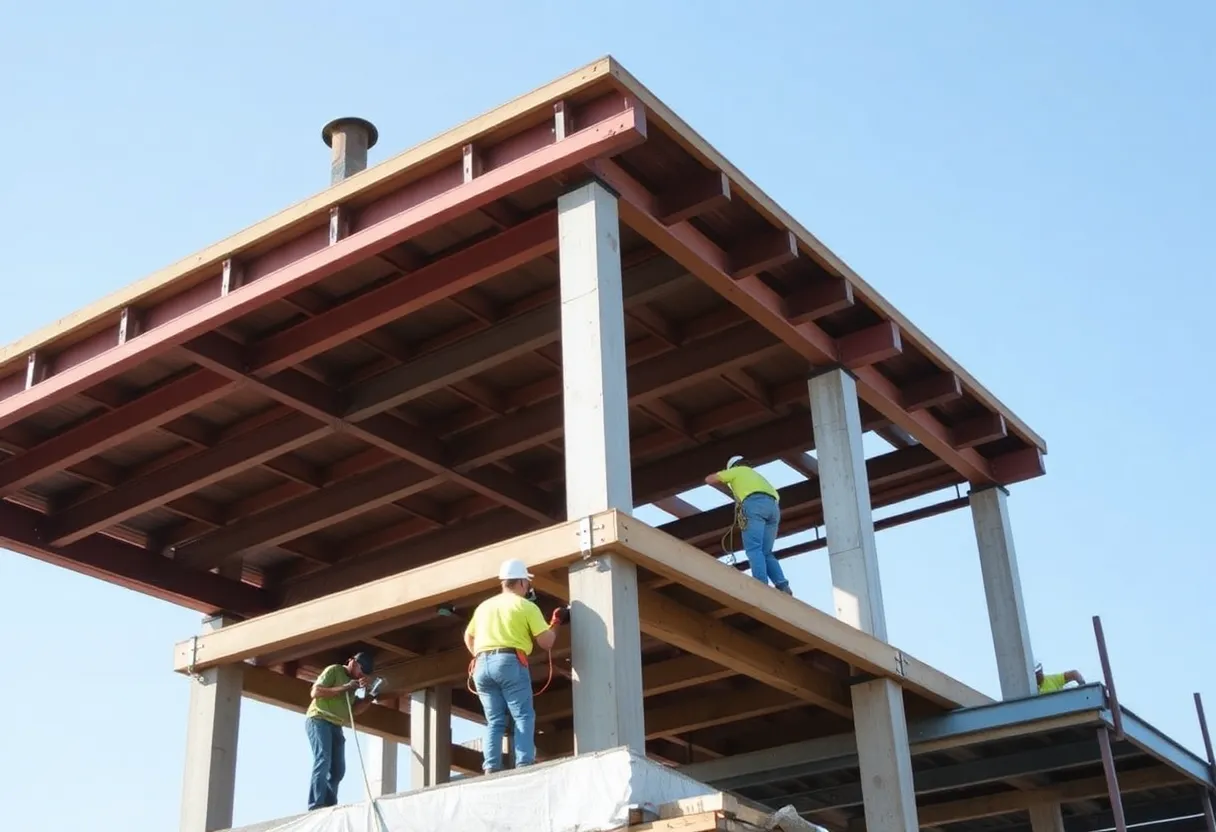Buffalo, New York, October 7, 2025
News Summary
The global Building Information Modeling (BIM) market is poised for rapid expansion, driven by advances in cloud computing, AI, VR/AR and IoT. Research forecasts significant market growth and strong CAGR as public and private sectors adopt BIM for complex projects, sustainability and smart-city initiatives. The USACE Buffalo District is applying BIM to infrastructure projects like Black Rock Lock miter gates and remediation at the Niagara Falls Store Site, reporting benefits in planning, clash detection and maintenance while facing challenges in file compatibility and data standards. Federal grants and labor dynamics further propel adoption across the industry.
Global BIM Market Set for Rapid Growth as USACE Buffalo District and Industry Expand Use
The global market for Building Information Modeling (BIM) was estimated at US$8.6 billion in 2023. ResearchAndMarkets projects the global BIM market will reach US$24.8 billion by 2030, representing ResearchAndMarkets projects a compound annual growth rate (CAGR) of 16.3% for BIM from 2023 to 2030. The report frames BIM as a core part of the shift toward digital transformation across design, construction, and operations for the built environment.
Why growth is sharp and near-term
Several plain drivers explain the jump in adoption and spending. Increasing complexity of modern building projects and the need to coordinate structural, mechanical, and electrical systems have pushed teams toward a single digital platform. Government mandates and regulatory requirements in many countries are requiring the use of BIM for large-scale infrastructure and public sector projects. Demand for sustainable construction practices and growing investment in smart cities are further propellants.
BIM replaces fragmented 2D drawings with a cohesive 3D model containing rich data on every component, from structural elements to systems like HVAC and electrical. The technology enables early identification of potential design clashes or system conflicts, minimizing costly rework and delays during construction. It also supports enhanced visualization and simulations of building performance before construction starts, and it serves operations and maintenance by providing a detailed, living record of a structure’s attributes.
Technology changes are accelerating capability
Advances in cloud computing, artificial intelligence (AI), virtual/augmented reality (VR/AR), and the Internet of Things (IoT) are making BIM more powerful. Cloud computing allows BIM data to be shared and accessed in real time by distributed stakeholders. AI integration with BIM can provide predictive analytics to foresee project risks, optimize schedules, anticipate material shortages, and identify potential design flaws. VR/AR allow stakeholders to immerse themselves in a 3D model and identify design issues prior to construction. IoT enables real-time data collection from sensors embedded in buildings that can be integrated into BIM models for ongoing performance analysis.
Public sector adoption: USACE Buffalo District
The Buffalo District is using BIM. The Buffalo District is using BIM to model projects such as miter gates for the Black Rock Lock in downtown Buffalo. The Buffalo District is using BIM for remediation work at the Niagara Falls Store Site. Since the district started using the technology, it has uncovered a host of benefits around planning and maintenance. ERDC documented the Fort Meade project and listed major benefits of BIM, including improved planning and maintenance. Challenges the Buffalo District faces with BIM include ensuring file compatibility and enforcing data standards. The Buffalo District views BIM as an investment in future technology.
A geodesist with the Buffalo District’s survey team noted that the entire scope of data that is collected helps to plan projects, design repairs or upgrades, track construction progress, monitor changes over time, and maintain and manage infrastructure. A civil engineer with the Buffalo District indicated that the adoption of BIM was a direct result of the government’s push for modernization, digital transformation and improved data management in infrastructure delivery.
Federal and private sector context
Federal funding has been used to encourage state departments of transportation and other public agencies to adopt digital tools. Last November, the Federal Highway Administration disbursed grants worth US$16.6 million to eight states under the Advanced Digital Construction Management Systems program. In the private sector, contractors have long used BIM. Examples include projects where contractors leaned heavily on design-assist and digital modeling to integrate systems across historic buildings.
Workforce and market dynamics
Labor shortages and an aging workforce are pushing firms to rely on digital tools. Global construction industry labor shortages and a declining workforce are factors driving BIM adoption; BIM helps automate aspects of design and construction management to do more with fewer resources. The rising trend of prefabrication and modular construction relies heavily on BIM for precise coordination and planning. Companies are placing emphasis on scaling technology opportunities across back office and project delivery, including connected construction, digital twin, and elevating BIM systems.
Industry outlook and spending trends
Construction spending crossed US$2 trillion and maintained a balanced trajectory in the first half of 2024. The sector’s employment level reached 8.3 million in July 2024. Between August 2023 and July 2024, the construction industry had an average of 382,000 job openings each month. Despite strong fundamentals, the industry faced a pervasive talent shortage and continued to be affected by high interest rates and price inflation in some segments. Government investments via major legislation are expected to continue driving activity in manufacturing and energy construction segments, which in turn supports increased use of digital technologies like BIM.
Report and research notes
The press release titled Building Information Modeling (BIM) – Global Strategic Business Report was added to a market research offering. The press release location and date: Dublin, Oct. 31, 2024. The press release describes BIM as a transformative technology revolutionizing construction by offering a digital representation of a building’s physical and functional characteristics across its lifecycle. The press release includes an invitation to visit a specific URL for more information and encourages purchasing the report for in-depth market trends, drivers, forecasts, and company profiles.
FAQ
What was the global market for Building Information Modeling (BIM) in 2023?
The global market for Building Information Modeling (BIM) was estimated at US$8.6 billion in 2023.
What is the projected market size for BIM by 2030?
ResearchAndMarkets projects the global BIM market will reach US$24.8 billion by 2030.
What is the projected CAGR for BIM from 2023 to 2030?
ResearchAndMarkets projects a compound annual growth rate (CAGR) of 16.3% for BIM from 2023 to 2030.
Which projects is the Buffalo District using BIM to model?
The Buffalo District is using BIM to model projects such as miter gates for the Black Rock Lock in downtown Buffalo. The Buffalo District is using BIM for remediation work at the Niagara Falls Store Site.
What challenges has the Buffalo District faced with BIM?
Challenges the Buffalo District faces with BIM include ensuring file compatibility and enforcing data standards.
What federal grants were mentioned to support digital construction?
Last November, the Federal Highway Administration disbursed grants worth US$16.6 million to eight states under the Advanced Digital Construction Management Systems program.
Key features at a glance
| Feature | Detail |
|---|---|
| Market size (2023) | The global market for Building Information Modeling (BIM) was estimated at US$8.6 billion in 2023. |
| Projected market (2030) | ResearchAndMarkets projects the global BIM market will reach US$24.8 billion by 2030. |
| Projected CAGR | ResearchAndMarkets projects a compound annual growth rate (CAGR) of 16.3% for BIM from 2023 to 2030. |
| Public sector adoption example | The Buffalo District is using BIM to model projects such as miter gates for the Black Rock Lock in downtown Buffalo; remediation work at the Niagara Falls Store Site. |
| Major technology enablers | Cloud computing, AI, VR/AR, and IoT. |
| Key benefits | Clash detection, improved planning and maintenance, visualization, lifecycle data for operations and maintenance. |
| Noted challenges | Ensuring file compatibility and enforcing data standards. |
| Relevant federal action | Last November, the Federal Highway Administration disbursed grants worth US$16.6 million to eight states under the Advanced Digital Construction Management Systems program. |
Deeper Dive: News & Info About This Topic
Additional Resources
- Construction Dive: USACE Buffalo District adopts BIM
- Wikipedia: Building information modeling
- Deloitte: Engineering and Construction industry outlook
- Google Search: Construction industry trends 2024
- G2 Learn: Construction statistics
- Google Scholar: Construction statistics 2024
- GlobeNewswire: Building Information Modeling (BIM) Industry research 2024
- Encyclopedia Britannica: Building information modeling
- BusinessWire: Artificial Intelligence (AI) in Construction report
- Google News: AI in construction
Author: Construction FL News
The FLORIDA STAFF WRITER represents the experienced team at constructionflnews.com, your go-to source for actionable local news and information in Florida and beyond. Specializing in "news you can use," we cover essential topics like product reviews for personal and business needs, local business directories, politics, real estate trends, neighborhood insights, and state news affecting the area—with deep expertise drawn from years of dedicated reporting and strong community input, including local press releases and business updates. We deliver top reporting on high-value events such as the Florida Build Expo, major infrastructure projects, and advancements in construction technology showcases. Our coverage extends to key organizations like the Associated Builders and Contractors of Florida and the Florida Home Builders Association, plus leading businesses in construction and legal services that power the local economy such as CMiC Global and Shutts & Bowen LLP. As part of the broader network, including constructioncanews.com, constructionnynews.com, and constructiontxnews.com, we provide comprehensive, credible insights into the dynamic construction landscape across multiple states.





